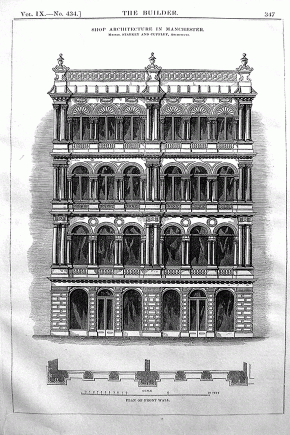Shop and Offices 86 Market Street Manchester
Considered the earliest example of a completely arcaded commercial building, the shops were opened on 12 January 1852 by Benjamin Hyam. Hyam came to Manchester from Ipswich in 1829 and set up what was probably the first enterprise in England to make and sell ready-made clothing. By the time he left Manchester for London in the 1850s he had at least 13 branches, three in the West End of London. Hyam employed out-workers to make up the clothing for an emerging middle class. Occupied by Times Furnishing Co.1956. Demolished
SOMETHING CRITICAL The specimen of street architecture in Manchester shows that the provincial shopocracy are determined not to lag behind their metropolitan brethren. Besides displaying spirited liberality in an unusual degree, the design is marked by an attention to architectural logic, which is sadly disregarded here in town, since, instead of presenting a continuous surface of glass without any apparent support to the rest of the front, the ground floor exhibits considerable construction, and the whole elevation is well and firmly put together. Still there are one or two matters which do not seem to have been quite so carefully considered as they might have been. Now, though such arrangement would have been contrary to rule, it would, I conceive, have been more judicious to have reversed the sequence of the orders, making the lower and loftier one Corinthian instead of Doric, and employed the latter for the third storey. So disposed, te richer order would have been approximated to the eye, consequently the capitals and details would have been more distinctly seen, especially as that first floor order is somewhat loftier than the others. Such arrangement would too have been in perfect accordance with the principle of according greater ornament on the windows, and other features of a first floor, than on those above it; besides which the characteristic proportions of the several orders would have been preserved; whereas now the Doric columns are of considerably more slender proportions than the Corinthian ones, so that the latter look comparatively stumpy, and the others lanky.
I am further of the opinion that the general effect would have been greatly better, had the entablatures over the smaller columns to the windows been omitted, and these columns carried up as high as the window-transoms, and the mouldings of the arches made to spring immediately from their capitals; whereby not only would some degree of fritter been avoided, but also the disagreeable effect (highly disagreeable, at least to my eye) occasioned by the columns being shorter than the head of the aperture beneath the arch, to the interruption of continuity of lines and levels. ZETA The Builder 7 June 1851 Page 362.
Reference The Builder 31 May 1851:347- illustration
Reference The Builder 7 June 1851 Page 362
